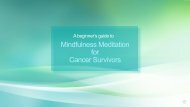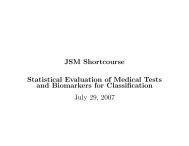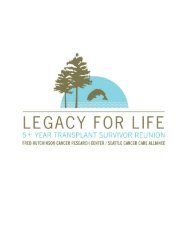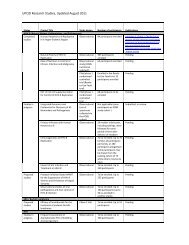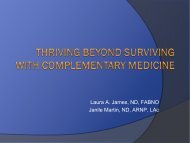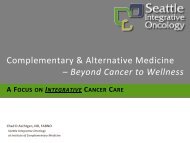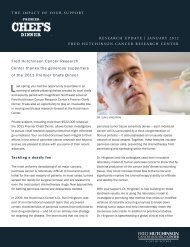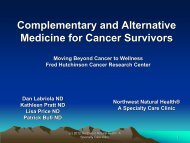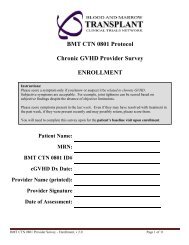Long Term Effects of Childhood Cancer
Long Term Effects of Childhood Cancer
Long Term Effects of Childhood Cancer
You also want an ePaper? Increase the reach of your titles
YUMPU automatically turns print PDFs into web optimized ePapers that Google loves.
Moving Beyond <strong>Cancer</strong> to Wellness:<br />
<strong>Long</strong> <strong>Term</strong> <strong>Effects</strong><br />
<strong>of</strong> <strong>Childhood</strong> <strong>Cancer</strong><br />
Eric Chow, MD<br />
Karen Wilkinson, ARNP<br />
<strong>Cancer</strong> Survivor Program<br />
(aka “ACCESS”)<br />
Seattle Children’s Hospital
100<br />
90<br />
80<br />
70<br />
60<br />
50<br />
40<br />
30<br />
20<br />
10<br />
1975-<br />
1977<br />
Pediatric <strong>Cancer</strong> Survival<br />
Overall 80% survival<br />
Estimated 300,000 childhood cancer survivors<br />
(~1 in 600 young adults)<br />
1978-<br />
1980<br />
1981-<br />
1983<br />
1984-<br />
1986<br />
1987-<br />
1989<br />
1990-<br />
1992<br />
1993-<br />
1995<br />
1996-<br />
1998<br />
1999-<br />
2006<br />
NCI SEER 9 Areas, 1975-2007, ages 0-19 yrs
100<br />
90<br />
80<br />
70<br />
60<br />
50<br />
40<br />
30<br />
20<br />
10<br />
1975-<br />
1977<br />
Pediatric <strong>Cancer</strong> Survival<br />
1978-<br />
1980<br />
1981-<br />
1983<br />
1984-<br />
1986<br />
1987-<br />
1989<br />
1990-<br />
1992<br />
1993-<br />
1995<br />
1996-<br />
1998<br />
Hodgkin Wilms' S<strong>of</strong>t tissue<br />
CNS Acute lymphocytic Neuroblastoma<br />
Bone Non-Hodgkin Acute myeloid<br />
All Sites<br />
1999-<br />
2006<br />
NCI SEER 9 Areas, 1975-2007, ages 0-19 yrs
End <strong>of</strong> Treatment<br />
• Many families identify end <strong>of</strong> treatment as a<br />
time <strong>of</strong> new uncertainty, frustration and<br />
stress<br />
“ We lived with these people (staff) for 8<br />
months, and then they say ‘ OK, you’re<br />
done, see you. We will see you in 3<br />
months. Bye.’ …..hey, wait a minute. This is<br />
really not over for us”.
Moving from <strong>Cancer</strong> Patient to Survivor<br />
• Transitions<br />
– End <strong>of</strong> treatment<br />
– Return to “normal”<br />
– Primary care provider & survivor program<br />
– Teens / Young Adults<br />
• Things to learn about<br />
– <strong>Cancer</strong> treatment summary<br />
– Follow-up schedule<br />
– Between visits<br />
– Late effects
• Diagnosis<br />
Survivor Knowledge<br />
– 91% knew (72% detailed knowledge)<br />
– 2% cancer<br />
– 7% unaware<br />
• Treatment<br />
– Radiation ~90% aware (70% knew site)<br />
– Anthracycline chemotherapy
Possible <strong>Long</strong>-term <strong>Effects</strong><br />
• Growth & Development<br />
– Growth deficiencies<br />
– Cognitive function<br />
– Hearing loss<br />
– Psychosocial distress<br />
• Fertility & Reproduction<br />
– Delayed or precocious<br />
puberty<br />
– Sterility<br />
• Other Organ<br />
Dysfunction<br />
– Endocrine<br />
– Heart<br />
– Lungs<br />
– Kidney and Bladder<br />
• Second <strong>Cancer</strong>s<br />
No one gets all these problems<br />
No one is completely unaffected by cancer<br />
– Premature menopause<br />
Most survivors lead healthy lives
Growth Issues<br />
• <strong>Effects</strong> <strong>of</strong> treatment on growing bodies<br />
– Radiation<br />
– Chemotherapy<br />
– Surgery<br />
• Hormone problems<br />
• Bone health<br />
• Brain development
Growth – Brain Development<br />
• Symptoms may include<br />
– Academic challenges and changes<br />
– Difficulty with multi-step processes<br />
– Feeling less sharp<br />
– Memory problems<br />
– Needing more effort to do things that previously<br />
came easily<br />
• Depends on therapy<br />
– Real changes can be seen in the brain<br />
– Younger ages may be at greater risk
Growth Issues – What can you do?<br />
• Regular preventive health care<br />
– Monitoring height, weight<br />
– Hearing and vision screens<br />
– Dental care<br />
– Screening labs<br />
• Work with schools / teachers if you<br />
suspect learning issues<br />
– Some survivors may benefit from early<br />
neurodevelopmental testing
Reproductive Outcomes<br />
• Can I have children?<br />
• How will my body respond to<br />
pregnancy?<br />
• Will my children be affected by prior<br />
treatment?<br />
– Congenital malformations<br />
– <strong>Cancer</strong><br />
– Other birth complications
Reproductive Outcomes<br />
• Treatments that may affect fertility<br />
– “Alkylator” chemotherapy<br />
– Radiation to brain, ovaries, testes<br />
– Dose dependent<br />
• Other issues<br />
– Females: possible effect on heart function<br />
during pregnancy<br />
• Offspring health<br />
– Appear healthy without risk <strong>of</strong><br />
malformations or cancer
Reproductive Outcomes<br />
– What can you do?<br />
• Advocate for improved fertility<br />
preservation education & resources<br />
prior to cancer treatment<br />
• Discuss need for fertility testing and<br />
referral to reproductive specialist, and<br />
possibly high-risk obstetrician<br />
• Adoption and other alternatives
Heart & Lung Issues<br />
• Heart disease<br />
– Risk related to ANTHRACYCLINE<br />
chemotherapy and chest radiation<br />
– Conditions that increase blood pressure or<br />
cholesterol levels also important<br />
• Lung disease<br />
– Risk related to BLEOMYCIN chemotherapy and<br />
chest radiation<br />
• Overall, risk influenced by age at treatment,<br />
treatment doses, time since treatment
Heart & Lung – What can you do?<br />
• Know if you/your child is at increased risk<br />
• Talk to your doctor about how best to<br />
monitor for these effects<br />
• Be aware <strong>of</strong> symptoms that may indicate<br />
heart or lung disease<br />
– Chest pain<br />
– Shortness <strong>of</strong> breath<br />
– Fatigue<br />
• Modify lifestyle issues<br />
– Avoid smoking<br />
– Be physically active
~3-fold<br />
increased risk<br />
Second <strong>Cancer</strong>s<br />
Pre-chemotherapy<br />
First generation chemo<br />
Combination therapy<br />
Olsen, JNCI 2009
Second <strong>Cancer</strong>s – What can you do?<br />
• KNOWLEDGE:<br />
– <strong>Cancer</strong> and its therapy can increase risk<br />
<strong>of</strong> another cancer<br />
– Know what may increase your/your<br />
child’s risk <strong>of</strong> subsequent cancer<br />
• Know what kind <strong>of</strong> treatment you/your child<br />
received<br />
• This includes knowing exploring your family<br />
history<br />
– Know if you/your child needs special<br />
screening that others their age do not<br />
typically need
Second <strong>Cancer</strong>s – What can you do?<br />
• ACTION:<br />
– Get the proper screening done<br />
– Lead a healthy lifestyle by avoiding<br />
• Excess sun exposure<br />
• Tobacco<br />
• Excess alcohol<br />
• Physical inactivity<br />
• Poor diet
<strong>Long</strong>-term Follow-up Goals<br />
• Stay as healthy as possible<br />
• Learn what you need to know about<br />
your treatment<br />
• Learn what is needed for follow-up<br />
care<br />
• Learn where you can obtain proper<br />
follow-up care
2005 Institute <strong>of</strong> Medicine Report<br />
“From <strong>Cancer</strong> Patient to <strong>Cancer</strong> Survivor:<br />
Lost in Transition”<br />
Importance <strong>of</strong> risk-based care with<br />
Individualized recommendations
Nathan, JCO 2009
Follow-up Schedule<br />
• Follow-up is based on specific disease<br />
and risk <strong>of</strong> relapse/recurrence<br />
• Establishing care with a primary care<br />
provider is highly recommended<br />
• Late effects and monitoring – should<br />
start by 2 years <strong>of</strong>f active therapy<br />
• <strong>Long</strong>-<strong>Term</strong> Follow-Up guidelines for<br />
Survivors <strong>of</strong> <strong>Childhood</strong>, Adolescent,<br />
and Young Adult <strong>Cancer</strong>s available at<br />
www.survivorshipguidelines.org
<strong>Cancer</strong> Survivor Program:<br />
Medical Home for Survivors<br />
• Need longitudinal care: a continuum from cancer<br />
diagnosis through adulthood, regardless <strong>of</strong> age<br />
• Continuity <strong>of</strong> care consisting <strong>of</strong> partnership between<br />
the survivor and a health care provider<br />
• Comprehensive, anticipatory, proactive care that<br />
includes a systemic & individualized plan <strong>of</strong><br />
prevention and surveillance<br />
• Multidisciplinary team approach with<br />
communication between primary provider &<br />
specialist(s)<br />
• Health care <strong>of</strong> whole person<br />
• Sensitivity to issues <strong>of</strong> the cancer experience
Survivor Program Services<br />
• Complete review <strong>of</strong> cancer tx records<br />
• Discussion <strong>of</strong> school/work,<br />
reproductive issues<br />
• Education for survivor and family<br />
• Referral to appropriate subspecialties<br />
• Communication/resource for<br />
community physician<br />
• Case management (medical home) for<br />
those with complex needs
Survivor Program Resources<br />
• <strong>Childhood</strong> <strong>Cancer</strong> Survivors: A practical guide to your<br />
future<br />
• Survivor Notebook<br />
– Detailed educational information on long-term problems that you and<br />
your child need to know about<br />
• Survivor Care Plan<br />
– Disease and date <strong>of</strong> diagnosis<br />
– Chemotherapy & radiation therapy<br />
– Surgeries<br />
– Hematopoietic cell transplant<br />
– Any other cancer therapy<br />
– Transfusions<br />
– Any significant complications<br />
– Associated potential risks <strong>of</strong> treatment<br />
– Screening and follow-up recommendations
Shifting Care from<br />
Parent/Caregiver to Survivor<br />
• From child to adult<br />
• Relationships with parents/siblings<br />
• Networking/advocacy<br />
• Insurance<br />
• Making healthy choices<br />
– Health protective choices<br />
– Health risk behaviors<br />
– Adult survivor program
Conclusions<br />
• Cure is not enough<br />
• Know what lies ahead for you and your child<br />
• Get educated and advocate<br />
• Participate in research<br />
• Let us work together to help you<br />
MOVE PAST CANCER TO WELLNESS!!<br />
With our thanks to all the patients and<br />
families who continue to teach us and<br />
help those who will face cancer in the<br />
future



